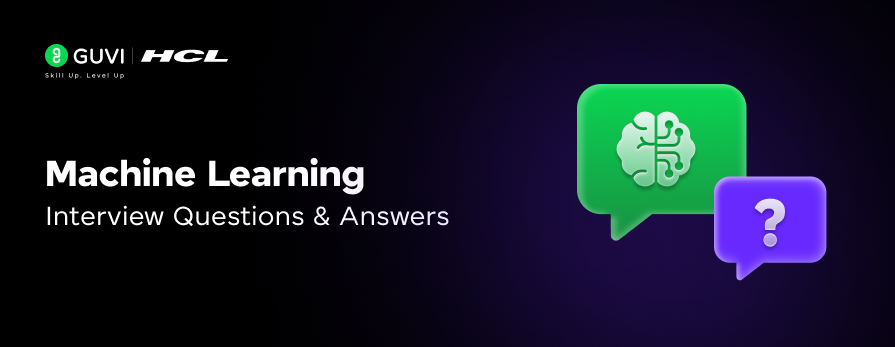
Top 65+ Machine Learning Interview Questions and Answers
Mar 07, 2025 15 Min Read 10686 Views
(Last Updated)
Machine Learning has become the cornerstone of innovation in today’s tech-driven world, powering applications from predictive analytics to self-driving cars. As the demand for skilled ML professionals surges, acing an interview in this competitive field requires not only a strong grasp of fundamentals but also the ability to tackle advanced, domain-specific challenges.
In this guide, I’ve compiled 65+ meticulously selected Machine Learning interview questions and answers to help you prepare effectively and confidently for your next ML interview, these are for all levels from freshers to professionals, and are divided into various branches of Machine Learning as well for thorough preparation, and I can assure they’re completely research-backed. Let’s begin!
Table of contents
- Top Machine Learning Interview Questions and Answers (Section-Wise)
- A) Beginner Level
- What is Machine Learning?
- Differentiate between Supervised, Unsupervised, and Reinforcement Learning.
- What is Overfitting? How can it be avoided?
- Explain the Bias-Variance Tradeoff.
- What is the difference between Parametric and Non-Parametric Models?
- What are Training, Validation, and Test Sets?
- What is Cross-Validation? Why is it used?
- Define Precision, Recall, and F1-Score.
- What is the Confusion Matrix?
- What are Feature Scaling Techniques?
- What is Gradient Descent?
- What is the purpose of a Cost Function?
- B) Intermediate Level
- Explain Regularization in Machine Learning.
- What is Feature Engineering?
- Differentiate between Bagging and Boosting.
- What is the Curse of Dimensionality?
- What is PCA? How does it work?
- What are Ensemble Learning Methods?
- How does Naive Bayes work?
- What is K-Means Clustering?
- What is the difference between Random Forest and Gradient Boosting?
- Explain Support Vector Machines (SVM).
- What is Logistic Regression?
- Explain the concept of Multi-Collinearity.
- What is the ROC Curve?
- How does Early Stopping work?
- What is AUC-ROC?
- C) Advanced Level
- D) Natural Language Processing (NLP)
- E) Deep Learning
- F) Reinforcement Learning (RL)
- G) Python
- Concluding Thoughts…
Top Machine Learning Interview Questions and Answers (Section-Wise)
I have divided all these important Machine Learning interview questions and answers into various sections for your ease of learning, I recommend covering the beginner level questions as a must and then going through all the sections one by one so that you can gain a well-rounded knowledge of how these interviews are undertaken and how much and what you should prepare.
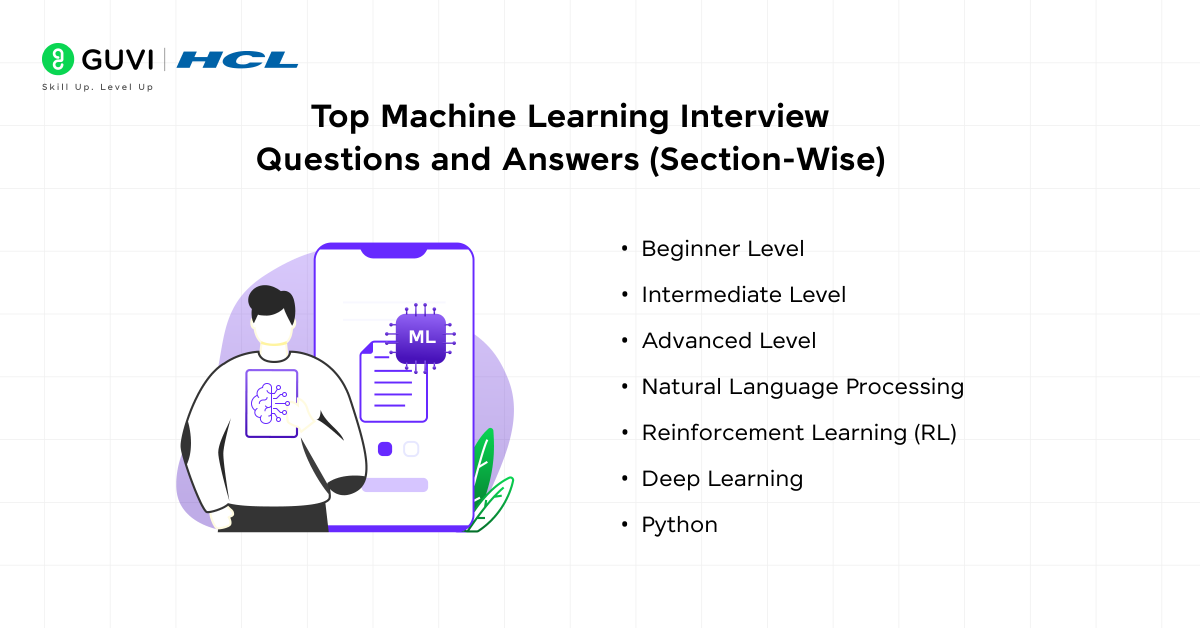
A) Beginner Level
1. What is Machine Learning?
Answer:
Machine Learning (ML) is a branch of Artificial Intelligence (AI) focused on developing systems that can learn and improve from data without explicit programming. It involves using algorithms to identify patterns and relationships within data, optimizing predictions or decisions based on a defined objective function. ML is widely used in applications like natural language processing, recommendation systems, and computer vision.
2. Differentiate between Supervised, Unsupervised, and Reinforcement Learning.
Answer:
- Works with labeled data, where each input is paired with a corresponding output.
- The goal is to learn a mapping function (e.g., y=f(x)y = f(x)y=f(x)).
- Examples: Classification (spam detection), Regression (house price prediction).
Unsupervised Learning:
- Analyzes unlabeled data to identify hidden patterns or structures.
- Common tasks include clustering (e.g., K-Means) and dimensionality reduction (e.g., PCA).
- Examples: Customer segmentation, anomaly detection.
Reinforcement Learning:
- Models learn to make decisions by interacting with an environment.
- Uses rewards and penalties to guide the learning process.
- Example: Training agents in games (AlphaGo), robotic control systems.
3. What is Overfitting? How can it be avoided?
Answer:
Overfitting occurs when a model learns the noise and specific details of the training data, leading to poor performance on unseen data.
Avoiding Overfitting:
- Cross-Validation: Splitting data into multiple folds to validate performance on unseen data.
- Regularization: Adds a penalty for large coefficients in the model (e.g., L1 for sparsity, L2 for smaller weights).
- Pruning: Simplifying complex models like decision trees by removing unnecessary branches.
- Early Stopping: Halting training when validation error stops decreasing.
- Dropout: Randomly deactivating neurons in neural networks during training to prevent dependency on specific nodes.
4. Explain the Bias-Variance Tradeoff.
Answer:
This tradeoff captures the relationship between model simplicity and complexity:
- Bias: Error from oversimplified assumptions; leads to underfitting (e.g., linear models on nonlinear data).
- Variance: Sensitivity to fluctuations in training data; leads to overfitting (e.g., high-degree polynomial models).
Optimal performance is achieved by balancing bias and variance through techniques like regularization and cross-validation.
5. What is the difference between Parametric and Non-Parametric Models?
Answer:
Parametric Models:
- Assume a specific form or distribution for the underlying data (e.g., linear relationships in Linear Regression).
- Require fewer parameters and are computationally efficient.
- Limitations: Poor flexibility in capturing complex patterns.
Non-Parametric Models:
- Make no assumptions about data distribution, adapting to the structure of the data (e.g., Decision Trees, KNN).
- Can handle complex datasets but may require more data and computational resources.
6. What are Training, Validation, and Test Sets?
Answer:
Training Set: Used to train the model by adjusting its parameters to minimize the error on this dataset.
Validation Set: Used during training to fine-tune hyperparameters and prevent overfitting.
Test Set: A separate dataset used after training to evaluate the model’s performance on unseen data.
7. What is Cross-Validation? Why is it used?
Answer:
Cross-validation is a technique to assess a model’s generalization ability by splitting data into multiple subsets:
- k-Fold Cross-Validation: The dataset is divided into kkk subsets, and the model is trained on k−1k-1k−1 folds while validating on the remaining fold, rotating folds iteratively.
- Purpose:
- Ensures the model generalizes well to unseen data.
- Reduces overfitting and provides a more robust evaluation.
8. Define Precision, Recall, and F1-Score.
Answer:
9. What is the Confusion Matrix?
Answer:
The Confusion Matrix is a table that evaluates the performance of a classification model by comparing predicted and actual classes. It includes:
- True Positives (TP), True Negatives (TN).
- False Positives (FP), False Negatives (FN).
It helps compute performance metrics like accuracy, precision, recall, and F1-score.
10. What are Feature Scaling Techniques?
Answer:
11. What is Gradient Descent?
Answer:
Gradient Descent is an optimization algorithm that minimizes the cost function by iteratively adjusting model parameters in the direction of the steepest descent.
- Learning rate (α\alphaα) controls step size.
- Variants: Batch Gradient Descent, Stochastic Gradient Descent, Mini-batch Gradient Descent.
12. What is the purpose of a Cost Function?
Answer:
The cost function measures the error between predicted and actual outputs, guiding model training by quantifying performance. Examples include:
- Mean Squared Error (MSE): For regression tasks.
- Cross-Entropy Loss: For classification tasks.
The model aims to minimize this function during training.
B) Intermediate Level
13. Explain Regularization in Machine Learning.
Answer:
14. What is Feature Engineering?
Answer:
Feature engineering is the process of creating or transforming input variables (features) to enhance the predictive performance of a model. It bridges the gap between raw data and machine learning algorithms.
Key Steps:
- Data Cleaning: Handling missing values, outliers, and noisy data.
- Feature Transformation: Scaling (e.g., normalization, standardization), log transformations, or polynomial features.
- Feature Selection: Identifying the most relevant features using statistical methods (e.g., mutual information, recursive feature elimination).
- Feature Creation: Generating new features by combining or splitting existing ones (e.g., creating interaction terms or time-based features).
For Example: In a sales dataset, combining “quantity sold” and “unit price” into a new feature, “total revenue,” may improve the model’s predictive power.
15. Differentiate between Bagging and Boosting.
Answer:
Bagging and Boosting are ensemble methods that combine multiple base models to improve performance, but they work differently:
- Bagging (Bootstrap Aggregating):
- Trains multiple models independently on random subsets of data (bootstrapped samples).
- Combines predictions through averaging (regression) or majority voting (classification).
- Reduces variance and improves stability.
- Example: Random Forest aggregates decisions from multiple decision trees to reduce overfitting.
- Boosting:
- Sequentially trains models, where each new model focuses on correcting errors of the previous ones.
- Assigns higher weights to misclassified examples.
- Reduces bias while maintaining low variance.
- Examples: AdaBoost, Gradient Boosting, XGBoost.
Key Difference: Bagging is parallel and variance-focused, while Boosting is sequential and bias-focused.
16. What is the Curse of Dimensionality?
Answer:
The Curse of Dimensionality refers to challenges that arise when analyzing data in high-dimensional spaces, where the number of features is very large.
Key Problems:
- Sparsity: Data points become sparse, making it difficult for models to generalize.
- Distance Metrics: Distances between points lose significance, reducing the effectiveness of algorithms like KNN or clustering.
- Overfitting: Models with too many features may fit noise rather than meaningful patterns.
Mitigation Techniques:
- Dimensionality reduction methods (e.g., PCA, t-SNE).
- Feature selection techniques (e.g., L1 regularization, mutual information).
17. What is PCA? How does it work?
Answer:
Principal Component Analysis (PCA) is a dimensionality reduction technique that transforms high-dimensional data into a smaller set of orthogonal components while retaining as much variance as possible.
Steps in PCA:
- Standardize Data: Ensure all features have a mean of 0 and unit variance.
- Covariance Matrix: Calculate the covariance matrix to understand feature relationships.
- Eigenvalues and Eigenvectors: Compute eigenvalues (variance explained) and eigenvectors (directions of principal components).
- Select Principal Components: Retain components that capture the majority of variance (e.g., 95%).
- Project Data: Transform original data onto the selected components.
Applications: Dimensionality reduction for visualization, noise reduction, and speeding up machine learning algorithms.
18. What are Ensemble Learning Methods?
Answer:
Ensemble learning combines predictions from multiple base models to improve overall performance, leveraging their strengths while minimizing individual weaknesses.
Types of Ensembles:
- Bagging (Variance Reduction):
- Combines independently trained models on different data subsets.
- Example: Random Forest aggregates results from multiple decision trees.
- Boosting (Bias Reduction):
- Sequentially trains models, focusing on examples misclassified by earlier models.
- Examples: AdaBoost, XGBoost, Gradient Boosting.
- Stacking:
- Combines predictions of multiple base models using a meta-model.
- Example: Logistic regression as the meta-model combining outputs from decision trees and SVM.
19. How does Naive Bayes work?
Answer:
20. What is K-Means Clustering?
Answer:
K-Means is an unsupervised algorithm that partitions data into kkk clusters based on proximity.
Steps:
- Initialize kkk centroids randomly.
- Assign each point to the nearest centroid.
- Recalculate centroids as the mean of assigned points.
- Repeat until centroids stabilize or a maximum number of iterations is reached.
Use Cases: Market segmentation, image compression, and anomaly detection.
21. What is the difference between Random Forest and Gradient Boosting?
Answer:
Random Forest:
- Ensemble of decision trees trained independently (bagging).
- Reduces variance.
- Suitable for large datasets, resistant to overfitting.
Gradient Boosting:
- Sequentially builds trees to minimize errors (boosting).
- Reduces bias.
- Performs well in competitive scenarios but is prone to overfitting if not regularized.
22. Explain Support Vector Machines (SVM).
Answer:
Support Vector Machines (SVM) is a supervised learning algorithm used for classification and regression tasks. It works by finding the optimal hyperplane that separates data points of different classes with the maximum margin.
Key Concepts:
- Hyperplane: A decision boundary that separates classes.
- Support Vectors: Data points closest to the hyperplane, which influence its position.
- Kernel Trick: Maps data into higher dimensions to make it linearly separable. Popular kernels include linear, polynomial, and Radial Basis Function (RBF).
- Objective: Maximize the margin (distance between the hyperplane and the support vectors) to improve generalization.
SVM is effective in high-dimensional spaces and robust to overfitting, especially with proper regularization.
23. What is Logistic Regression?
Answer:
Logistic Regression is a statistical method for binary classification. Instead of predicting a continuous output, it models the probability of the target belonging to a particular class using the sigmoid (logistic) function.
Key Points:
- Output: Produces probabilities between 0 and 1, which are converted into binary classes using a threshold (e.g., 0.5).
- Assumptions: Independent variables are linearly related to the log odds.
Common use cases include fraud detection and disease prediction.
24. Explain the concept of Multi-Collinearity.
Answer:
Multi-collinearity occurs when two or more independent variables in a regression model are highly correlated, leading to instability in coefficient estimates. This can reduce the interpretability and reliability of the model.
Effects:
- Large standard errors for coefficients.
- High sensitivity of coefficients to small data changes.
Detection Methods:
- Variance Inflation Factor (VIF): A VIF > 10 indicates high multi-collinearity.
- Correlation Matrix: Highlights strong correlations between predictors.
Solutions:
- Remove or combine highly correlated variables.
- Use dimensionality reduction techniques like PCA.
- Apply regularization (e.g., Ridge Regression).
25. What is the ROC Curve?
Answer:
The Receiver Operating Characteristic (ROC) curve is a graphical representation of a classifier’s performance across different classification thresholds.
A perfect classifier would have a ROC curve that passes through the top-left corner, indicating 100% sensitivity and 0% false positives.
26. How does Early Stopping work?
Answer:
Early stopping is a regularization technique used in iterative training algorithms like gradient descent. It monitors the model’s performance on a validation set and stops training when performance no longer improves.
Steps:
- Train the model and evaluate on the validation set after each epoch.
- Track validation loss or accuracy.
- Stop training when performance stops improving or starts degrading (to avoid overfitting).
Benefits:
- Prevents overfitting by stopping before the model becomes too complex.
- Saves computational resources by halting unnecessary training.
27. What is AUC-ROC?
Answer:
AUC-ROC (Area Under the ROC Curve) is a single scalar value summarizing the performance of a binary classifier.
Key Points:
- AUC: The area under the ROC curve, ranging from 0 to 1. A higher value indicates better discriminatory ability.
- Interpretation:
- AUC = 1: Perfect classifier.
- AUC = 0.5: No discrimination (random guessing).
- AUC < 0.5: Worse than random.
AUC-ROC is widely used because it evaluates classifier performance across all thresholds and provides an intuitive measure of the trade-off between sensitivity and specificity.
Would you like to ace your ML interviews? Then, the Artificial Intelligence and Machine Learning Course offered by GUVI is a comprehensive program designed to equip learners with essential skills in machine learning and AI, perfect for both beginners and those preparing for interviews.
The course covers key topics such as supervised learning, deep learning, and NLP, with hands-on projects and real-world applications. Learners will gain proficiency in top tools like Python, TensorFlow, Keras, and scikit-learn. With 24/7 access to resources, expert guidance, and a job-oriented curriculum, it’s an excellent choice for anyone aiming to master ML concepts and secure roles in the field.
C) Advanced Level
28. What is the role of eigenvalues and eigenvectors in PCA?
Answer:
Eigenvalues and eigenvectors are crucial in PCA (Principal Component Analysis) as they identify the principal components:
- Eigenvalues: Represent the variance explained by each principal component. Higher eigenvalues indicate more significant components.
- Eigenvectors: Define the direction of the principal components in the feature space.
PCA projects the data onto the eigenvectors associated with the largest eigenvalues, thereby reducing dimensionality while retaining maximum variance.
29. How does the Random Forest algorithm handle overfitting?
Answer:
Random Forest reduces overfitting by:
- Averaging Predictions: Combines predictions from multiple decision trees, lowering variance.
- Random Feature Selection: Ensures individual trees focus on different subsets of features, reducing correlation between trees.
- Bootstrap Aggregation (Bagging): Trains trees on different random subsets of the dataset, enhancing generalization.
These mechanisms create a robust ensemble model less prone to overfitting compared to a single decision tree.
30. What is the role of a learning rate in Gradient Descent?
Answer:
The learning rate (η\etaη) controls the step size at each iteration of the gradient descent optimization process:
- Small Learning Rate: Ensures stable convergence but increases computation time.
- Large Learning Rate: Speeds up convergence but risks overshooting the minima or divergence.
- Optimal Learning Rate: Balances convergence speed and stability. Techniques like learning rate schedules or adaptive optimizers (e.g., Adam) can dynamically adjust the rate.
31. Explain how Support Vector Machines (SVM) work.
Answer:
SVM is a supervised learning algorithm that finds the hyperplane best separating classes in a feature space:
- Maximizing Margin: SVM determines the hyperplane with the maximum margin (distance) between classes.
- Support Vectors: Data points closest to the hyperplane that influence its position.
- Kernel Trick: Maps non-linear data into a higher-dimensional space for linear separation using kernels like polynomial, RBF, or sigmoid.
SVM is effective for both linear and non-linear classification problems.
32. What is the difference between KNN and K-Means Clustering?
Answer:
| Aspect | KNN (K-Nearest Neighbors) | K-Means Clustering |
| Type | Supervised Learning | Unsupervised Learning |
| Purpose | Classification or Regression | Clustering |
| How It Works | Assigns labels based on the majority label of kkk nearest neighbors. | Groups data into kkk clusters by minimizing intra-cluster variance. |
| Distance Metric | Used for finding nearest neighbors. | Used for assigning points to clusters. |
| Training | Lazy (no explicit training phase). | Iterative (training phase to find centroids). |
KNN is predictive, while K-Means is descriptive.
33. What is the difference between Batch Gradient Descent and Stochastic Gradient Descent?
Answer:
Batch Gradient Descent:
- Involves computing the gradient of the cost function using the entire dataset before updating the parameters.
- Pros: More stable and deterministic convergence.
- Cons: Computationally expensive for large datasets as it requires processing the entire dataset in each iteration.
Stochastic Gradient Descent (SGD):
- Computes the gradient and updates parameters for each individual data point.
- Pros: Faster and more suitable for large datasets.
- Cons: Convergence can be noisy and less stable compared to Batch Gradient Descent.
34. What is the difference between a Generative and Discriminative Model?
Answer:
Generative Model:
- Models the joint probability
and can generate new data points.
- Examples: Naive Bayes, Variational Autoencoders.
- Use Case: Image synthesis, speech generation.
Discriminative Model:
- Models the conditional probability
, focusing solely on decision boundaries.
- Examples: Logistic Regression, SVM.
- Use Case: Classification tasks.
35. How do you handle imbalanced datasets in classification problems?
Answer:
Techniques include:
Resampling Techniques:
- Oversampling the minority class (e.g., SMOTE).
- Undersampling the majority class.
Class Weights:
- Assign higher penalties to misclassification of the minority class in the loss function.
Data Augmentation:
- Generate synthetic data for the minority class.
Algorithm-Specific Approaches:
- Use algorithms like XGBoost, which handle class imbalance through built-in parameters.
Evaluation Metrics:
- Use metrics like Precision, Recall, F1-Score, and AUC-ROC instead of Accuracy.
36. What is a Variational Autoencoder (VAE) and how do they work?
Answer:
A Variational Autoencoder (VAE) is a generative model that learns a probabilistic latent space for data generation, combining deep learning with Bayesian inference.
How They Work:
- Encoder: Maps input data to a latent probability distribution q(z∣x)q(z|x)q(z∣x).
- Latent Space: Introduces randomness by sampling from the learned distribution.
- Decoder: Reconstructs the input data from the latent representation zzz.
- Loss Function: Combines reconstruction loss (e.g., MSE) and Kullback-Leibler (KL) divergence to encourage meaningful latent representations.
37. Explain the concept of Entropy in Decision Trees.
Answer:
Entropy is a measure of impurity or randomness in a dataset. It quantifies the uncertainty in the target variable.
38. What is Transfer Learning? When is it used?
Answer:
Transfer Learning is a technique in Machine Learning where a model trained on one task (source domain) is fine-tuned or adapted to perform a different but related task (target domain). Instead of training a model from scratch, Transfer Learning leverages pre-trained models to save computational resources and time.
When it is used:
- Small Dataset Scenarios: When labeled data for the target task is limited.
- Domain Similarity: When the source and target tasks share underlying features (e.g., image recognition to medical imaging).
- Pre-trained Models: Common in NLP (using BERT, GPT) or computer vision (using ResNet, VGG).
39. How do Gradient Boosting and XGBoost differ?
Answer:
Gradient Boosting: A sequential ensemble method that builds models iteratively, minimizing the residual error by adding weak learners (usually decision trees).
XGBoost: An optimized version of Gradient Boosting offering advanced features for efficiency and accuracy.
Key Differences:
- Speed: XGBoost is faster due to parallel processing and tree pruning.
- Regularization: XGBoost includes L1/L2 regularization to prevent overfitting, whereas Gradient Boosting lacks built-in regularization.
- Handling Missing Values: XGBoost has an inbuilt mechanism to manage missing values.
- Objective Functions: XGBoost supports a wider range of objective functions (e.g., logistic, ranking).
40. What is Federated Learning?
Answer:
Federated Learning is a decentralized approach to training machine learning models where data remains on local devices, and only model updates (e.g., gradients) are shared with a central server.
Key Features:
- Data Privacy: Sensitive data never leaves local devices.
- Collaborative Training: Enables training on large-scale, distributed datasets.
Use Cases: - Mobile devices (e.g., personalized keyboard suggestions).
- Healthcare (training models across multiple hospitals without data sharing).
Challenges: Communication overhead, model synchronization, and heterogeneity in local data distributions.
41. Explain Bayesian Optimization.
Answer:
Bayesian Optimization is a probabilistic method for optimizing black-box functions that are expensive to evaluate. It uses a surrogate model (usually a Gaussian Process) to model the objective function and an acquisition function to decide where to evaluate next.
Steps:
- Build a surrogate model of the objective function.
- Use the acquisition function (e.g., Expected Improvement) to select the next point to evaluate.
- Update the surrogate model with the new data.
Advantages:
- Efficient for hyperparameter tuning in ML models (e.g., finding optimal learning rates or tree depths).
- Handles non-convex, noisy, and expensive-to-evaluate functions.
42. What is Gradient Clipping?
Answer:
Gradient Clipping is a technique used to prevent exploding gradients during backpropagation, especially in deep learning models. When gradients exceed a threshold, they are scaled down to keep them within the range.
Types:
- Norm-based Clipping: Scales gradients so that their norm doesn’t exceed a pre-set threshold.
- Value Clipping: Limits individual gradient values to a range.
Use Cases: - Recurrent Neural Networks (RNNs) and LSTMs where exploding gradients are common.
- Stabilizes training for models with high learning rates or long dependencies.
D) Natural Language Processing (NLP)
43. What is Tokenization in NLP, and why is it important?
Answer:
Tokenization in NLP is the process of splitting text into smaller units, such as words, subwords, or sentences. These units, called tokens, are the basic building blocks for text analysis and model input.
Importance:
- Facilitates syntactic and semantic processing of text.
- Helps standardize input for algorithms like Bag of Words or Word Embedding.
- Essential for tasks like sentiment analysis, machine translation, and text summarization.
44. Explain the concept of Bag of Words (BoW).
Answer:
The Bag of Words (BoW) is a text representation model that converts text data into numerical format by counting word occurrences in a document, ignoring grammar and word order.
- How it works: A vocabulary of unique words is created, and each document is represented as a sparse vector of word frequencies.
- Limitations:
- Ignores context and semantics.
- Results in high-dimensional, sparse vectors for large vocabularies.
45. What is Word Embedding, and how does it differ from one-hot encoding?
Answer:
Word Embedding represents words as dense, low-dimensional vectors in a continuous vector space, capturing semantic relationships between words. Examples include Word2Vec and GloVe.
Differences from One-Hot Encoding:
- One-Hot Encoding: Creates sparse, high-dimensional vectors with no semantic meaning (binary representation).
- Word Embedding: Produces dense, meaningful representations, reducing dimensionality and capturing relationships like “king – man + woman ≈ queen.”
46. What is the purpose of Stop Word Removal in NLP?
Answer:
Stop Word Removal eliminates common, non-informative words (e.g., “is,” “the,” “and”) from text data to focus on meaningful content.
Purpose:
- Reduces noise in the dataset.
- Improves computational efficiency by shrinking feature space.
- Enhances the relevance of features in tasks like text classification or clustering.
47. Explain Named Entity Recognition (NER).
Answer:
NER is an NLP task that identifies and classifies named entities in text into predefined categories such as person names, organizations, locations, dates, and numerical values.
Example:
Input: “Google was founded in 1998 by Larry Page and Sergey Brin in California.”
Output: [Google – Organization], [1998 – Date], [Larry Page – Person], [California – Location].
Applications: Information retrieval, question answering, and entity linking.
48. What is the difference between TF-IDF and CountVectorizer?
Answer:
CountVectorizer: Converts text into a matrix of word counts, focusing on the frequency of words in a document.
TF-IDF (Term Frequency-Inverse Document Frequency): Extends CountVectorizer by weighing word frequency with its importance.
- TF: Measures frequency of a term in a document.
- IDF: Discounts common terms across multiple documents.
Key Difference: TF-IDF penalizes frequently occurring terms to emphasize rarer, more informative ones, making it superior for text relevance tasks.
49. How does the Transformer architecture revolutionize NLP?
Answer:
The Transformer architecture, introduced in the paper “Attention is All You Need”, revolutionized NLP by leveraging self-attention mechanisms to process sequences without requiring recurrence or convolution.
Key Features:
- Self-Attention: Captures global dependencies in sequences, unlike RNNs, which focus on sequential data.
- Parallelism: Enables faster training by processing entire sequences simultaneously.
- Applications: Foundation of state-of-the-art models like BERT, GPT, and T5, leading to significant advancements in tasks like text generation, translation, and summarization.
E) Deep Learning
50. What is the difference between a Feedforward Neural Network and a Recurrent Neural Network (RNN)?
Answer:
Feedforward Neural Network (FNN):
- Architecture: FNNs are the most basic type of neural network. Information flows in one direction—from input to output—through hidden layers, with no loops or cycles.
- Data Processing: FNNs process data in a static manner, meaning that the output at a given time step is dependent only on the current input and previous layer activations.
- Applications: Used for tasks like classification, regression, and function approximation where the data is independent and not sequential (e.g., image classification, tabular data).
Recurrent Neural Network (RNN):
- Architecture: RNNs are designed to handle sequential data by introducing loops in the network. This allows them to maintain hidden states, making the output at each time step dependent on both the current input and the previous state.
- Data Processing: RNNs capture temporal dependencies, which makes them ideal for sequence-based tasks, such as time series forecasting, natural language processing (NLP), and speech recognition.
- Applications: Used for tasks where the sequence order is important, like text generation, machine translation, and speech-to-text.
Key Difference:
The main difference is that FNNs assume input data is independent, while RNNs are designed to process sequences of data, retaining information from previous time steps via hidden states.
51. What is the purpose of Activation Functions in Neural Networks? Name a few.
Answer:
Activation functions introduce non-linearity into the model, enabling it to learn complex patterns in data. Without them, neural networks would only be able to model linear relationships, no matter how deep the architecture. Activation functions allow the network to approximate any function, making deep learning models powerful for tasks such as classification, regression, and object detection.
Common Activation Functions:
- Sigmoid: Outputs values between 0 and 1; commonly used for binary classification.
- ReLU (Rectified Linear Unit): Outputs the input if positive, else zero. Helps mitigate vanishing gradients.
- Tanh: Outputs values between -1 and 1; similar to Sigmoid but with zero-centered outputs.
- Softmax: Used in the output layer of multi-class classification to normalize output to probabilities.
52. Explain the concept of Backpropagation in Neural Networks.
Answer:
Backpropagation is a supervised learning algorithm used to optimize the weights of a neural network by minimizing the loss function. It works through the following steps:
- Forward Pass: Input data is passed through the network to compute predictions.
- Loss Calculation: The loss function (e.g., Mean Squared Error) is computed by comparing predicted values with actual outputs.
- Backward Pass: The gradient of the loss with respect to each weight is computed using the chain rule of calculus. This tells us how much each weight contributed to the error.
- Weight Update: Using an optimization algorithm like Gradient Descent, the weights are adjusted in the opposite direction of the gradient to minimize the loss.
53. What is a Convolutional Neural Network (CNN), and where is it used?
Answer:
A Convolutional Neural Network (CNN) is a deep learning architecture primarily designed for processing structured grid-like data such as images. CNNs leverage convolutional layers to automatically detect spatial hierarchies in data by applying filters (kernels) to input images, followed by pooling layers that reduce spatial dimensions. This makes CNNs highly effective for tasks where data has spatial correlations, such as image classification, object detection, and semantic segmentation.
Applications:
- Computer Vision: Image classification, face recognition, object detection.
- Medical Imaging: Tumor detection in X-rays, MRI scans.
- Autonomous Vehicles: Object recognition and road sign detection.
54. How does Dropout help in preventing overfitting in Deep Learning?
Answer:
Dropout is a regularization technique used in neural networks to prevent overfitting. During training, dropout randomly disables a percentage of neurons in the network during each forward and backward pass.
This forces the network to not rely on any single neuron, thereby encouraging it to learn more robust features that generalize better to unseen data. Dropout effectively reduces the model’s capacity to memorize the training data, improving its ability to generalize and perform well on test data.
Typical Dropout Rate: 0.2 to 0.5 (e.g., 20%-50% of neurons are dropped).
55. What are the differences between LSTMs and GRUs?
Answer:
Long Short-Term Memory (LSTM) and Gated Recurrent Unit (GRU) are both types of Recurrent Neural Networks (RNNs) designed to address the vanishing gradient problem in traditional RNNs, but they differ in their architectures:
- LSTM:
- Consists of three gates: Input gate, Forget gate, and Output gate.
- Uses a cell state to store long-term dependencies.
- More complex with more parameters, allowing it to model more intricate patterns.
- Performs better on longer sequences but requires more computational resources.
- GRU:
- Combines the Forget and Input gates into a single update gate.
- Does not use a separate cell state, relying only on hidden states.
- Simpler than LSTM with fewer parameters, making it computationally more efficient.
- Generally performs well with shorter sequences and has been shown to converge faster than LSTMs.
Key Difference: LSTMs have more gates and a separate memory cell, whereas GRUs have a simplified structure with fewer gates and no separate memory cell.
56. What is Transfer Learning in Deep Learning, and why is it effective?
Answer:
Transfer Learning:
- Definition: Transfer learning involves taking a pre-trained model (usually trained on a large dataset for a similar task) and fine-tuning it on a smaller, domain-specific dataset. This is typically used when you have limited data but want to leverage the knowledge gained from large-scale models trained on vast datasets.
- How it works:
- Pre-training: A model is first trained on a large dataset (e.g., ImageNet for image classification tasks).
- Fine-tuning: The model is then adapted to a new, smaller dataset, usually by freezing the lower layers (which learn general features) and training only the higher layers (which learn task-specific features).
Why it is effective:
- Reduced Training Time: Since the model already has learned low-level features (edges, textures, etc.) from a large dataset, fine-tuning on the target dataset requires fewer epochs, speeding up training significantly.
- Improved Performance: Fine-tuning allows the model to learn high-level, domain-specific features, leading to better generalization even on smaller datasets.
- Lower Data Requirements: Transfer learning mitigates the problem of having limited data by enabling the use of large pre-trained models, making it effective for applications with small datasets or rare tasks.
- Resource Efficiency: Training deep learning models from scratch is computationally expensive. By using pre-trained models, we can significantly reduce both time and computational costs.
For Example:
In image recognition, a model pre-trained on ImageNet can be fine-tuned for a specific task like medical image classification, requiring fewer labeled images and computational resources.
F) Reinforcement Learning (RL)
57. What is Reinforcement Learning?
Answer:
Reinforcement Learning (RL) is a type of machine learning where an agent learns to make decisions by interacting with an environment. The goal is to maximize a cumulative reward signal over time by taking actions that lead to favorable outcomes. The agent learns through trial and error, receiving feedback in the form of rewards or penalties.
Unlike supervised learning, RL doesn’t rely on labeled data; instead, it relies on an agent’s experiences and its ability to explore and exploit the environment. Key components of RL include the agent, the environment, states, actions, rewards, and a policy that dictates the agent’s actions.
- Key Elements:
- State: The current situation.
- Action: The decision taken.
- Reward: Feedback from the environment.
58. What is Deep Q-Learning (DQN)?
Answer:
Deep Q-Learning (DQN) is an advanced form of Reinforcement Learning where deep neural networks are used to approximate the Q-value function. In traditional Q-Learning, a Q-table is used to store action-value pairs, but it’s infeasible for high-dimensional problems like image-based tasks.
DQN overcomes this by using a neural network (the Q-network) to estimate the Q-values. The algorithm uses experience replay (storing past transitions in a buffer) and target networks (a copy of the Q-network) to stabilize training. DQN is notable for its success in playing Atari games directly from raw pixel data.
59. Explain the role of exploration vs. exploitation in RL.
Answer:
In Reinforcement Learning, exploration refers to the agent’s ability to try new actions that might lead to higher long-term rewards, while exploitation is the agent’s tendency to choose actions that have already provided high rewards in the past. The balance between these two is crucial:
- Exploration helps discover new states and actions that may yield better rewards in the future, preventing the agent from getting stuck in suboptimal policies.
- Exploitation allows the agent to maximize immediate rewards by choosing actions known to be effective.
Balancing exploration and exploitation is managed by algorithms like epsilon-greedy, where the agent explores randomly with probability epsilon and exploits the best-known action with the remaining probability.
60. Explain Hyperparameter Optimization Techniques.
Answer:
Hyperparameter optimization is crucial for improving model performance, as the choice of hyperparameters significantly impacts a model’s ability to generalize. Some popular optimization techniques are:
- Grid Search: A brute-force method where a predefined set of hyperparameters is tested exhaustively. It’s simple but computationally expensive.
- Random Search: Samples hyperparameter combinations randomly. It can be more efficient than grid search, especially for large search spaces.
- Bayesian Optimization: Models the performance of hyperparameters as a probabilistic function and uses this model to select the most promising configurations.
- Genetic Algorithms: A population-based approach inspired by natural selection, where multiple hyperparameter sets are iteratively evolved through crossover and mutation operations.
- Gradient-based Optimization: Uses gradients of hyperparameters to optimize their values, though it’s more applicable to differentiable hyperparameters.
61. Explain GANs.
Answer:
Generative Adversarial Networks (GANs) are a class of deep learning models designed to generate new data that mimics an existing distribution. A GAN consists of two neural networks: the Generator and the Discriminator.
- Generator: Tries to create realistic data (e.g., images) from random noise.
- Discriminator: Tries to distinguish between real data (from the true distribution) and fake data (produced by the Generator). These networks are trained together in an adversarial setting—while the Generator improves to create more realistic data, the Discriminator becomes better at detecting fake data. The training process continues until the Generator’s outputs are indistinguishable from real data, leading to a robust model that can generate new, synthetic data. GANs are widely used in image generation, video synthesis, and other creative AI applications.
G) Python
62. How would you handle missing data in a dataset using Python?
Answer:
Handling missing data is crucial to building reliable machine learning models. You can handle missing data in several ways using pandas in Python:
Removing missing values: You can drop rows or columns with missing data.
df.dropna() # Drops rows with missing values
df.dropna(axis=1) # Drops columns with missing valuesFilling missing values: You can fill missing data using mean, median, or mode for numerical columns and the most frequent value for categorical columns.
df.fillna(df.mean()) # For numerical data
df.fillna(df['column_name'].mode()[0]) # For categorical dataImputation: Using sklearn’s SimpleImputer for more complex strategies like filling with the mean, median, or using a constant value.
from sklearn.impute import SimpleImputer
imputer = SimpleImputer(strategy='mean') # You can choose 'median', 'most_frequent'
df_imputed = pd.DataFrame(imputer.fit_transform(df), columns=df.columns)63. Explain how to split a dataset into training and testing sets in Python.
Answer:
You can split a dataset into training and testing sets using the train_test_split function from the sklearn.model_selection module. It randomly splits the data into training and testing subsets.
from sklearn.model_selection import train_test_split
# X: Features, y: Target variable
X_train, X_test, y_train, y_test = train_test_split(X, y, test_size=0.2, random_state=42)- test_size: Defines the proportion of data for testing (e.g., 0.2 means 20% for testing, 80% for training).
- random_state: Sets the random seed for reproducibility.
64. What are Python libraries commonly used for Machine Learning?
Answer:
Common Python libraries for Machine Learning include:
- Scikit-learn: Used for data preprocessing, machine learning algorithms, and model evaluation.
- TensorFlow/Keras: Popular for deep learning applications.
- Pandas: Data manipulation and cleaning.
- NumPy: Numerical operations on large datasets.
- Matplotlib/Seaborn: Data visualization.
- XGBoost/LightGBM: Efficient gradient boosting libraries for fast and scalable models.
- Statsmodels: Statistical modeling and hypothesis testing.
65. Write Python code to implement feature scaling.
Answer:
Feature scaling is important to normalize data before feeding it into ML models, particularly when using distance-based algorithms like KNN and SVM.
You can scale features using StandardScaler or MinMaxScaler from sklearn.preprocessing.
Standard Scaling (Z-score Normalization):
from sklearn.preprocessing import StandardScaler
scaler = StandardScaler()
X_scaled = scaler.fit_transform(X)Min-Max Scaling (scales features to a range [0, 1]):
from sklearn.preprocessing import MinMaxScaler
scaler = MinMaxScaler()
X_scaled = scaler.fit_transform(X)66. How would you implement cross-validation in Python?
Answer:
Cross-validation helps in assessing the model’s performance by splitting the dataset into multiple subsets. The KFold or StratifiedKFold classes from sklearn.model_selection can be used to perform k-fold cross-validation.
Example using KFold:
from sklearn.model_selection import KFold
from sklearn.model_selection import cross_val_score
from sklearn.ensemble import RandomForestClassifier
# Define the model
model = RandomForestClassifier()
# Define the cross-validation method
kf = KFold(n_splits=5, shuffle=True, random_state=42)
# Compute cross-validation scores
cv_scores = cross_val_score(model, X, y, cv=kf)
print(cv_scores)- n_splits: Number of folds (e.g., 5-fold cross-validation).
- shuffle=True: Shuffles the data before splitting into folds.
67. How do you tune hyperparameters in Python?
Answer:
Hyperparameter tuning is critical to improving the model’s performance. GridSearchCV and RandomizedSearchCV from sklearn.model_selection can be used to automate the process of hyperparameter optimization.
GridSearchCV: Exhaustively searches through a specified parameter grid.
from sklearn.model_selection import GridSearchCV
from sklearn.ensemble import RandomForestClassifier
model = RandomForestClassifier()
param_grid = {
'n_estimators': [50, 100, 200],
'max_depth': [10, 20, 30]
}
grid_search = GridSearchCV(estimator=model, param_grid=param_grid, cv=5)
grid_search.fit(X_train, y_train)
print(grid_search.best_params_)RandomizedSearchCV: Randomly samples the hyperparameter space for faster results.
from sklearn.model_selection import RandomizedSearchCV
from sklearn.ensemble import RandomForestClassifier
model = RandomForestClassifier()
param_distributions = {
'n_estimators': [50, 100, 200, 300],
'max_depth': [10, 20, 30, None]
}
random_search = RandomizedSearchCV(estimator=model, param_distributions=param_distributions, n_iter=10, cv=5)
random_search.fit(X_train, y_train)
print(random_search.best_params_)68. How can you visualize the correlation matrix of a dataset in Python?
Answer:
You can use seaborn and matplotlib to visualize the correlation matrix in Python. The heatmap function from seaborn is particularly useful.
Example:
import seaborn as sns
import matplotlib.pyplot as plt
# Calculate correlation matrix
corr_matrix = df.corr()
# Visualize correlation matrix using a heatmap
plt.figure(figsize=(10, 8))
sns.heatmap(corr_matrix, annot=True, cmap='coolwarm', fmt='.2f', linewidths=0.5)
plt.title('Correlation Matrix')
plt.show()- annot=True: Displays correlation values on the heatmap.
- cmap=’coolwarm’: Chooses the color scheme.
Concluding Thoughts…
Mastering Machine Learning interviews cannot be cleared by just memorizing concepts—you will need an understanding of their real-world applications, showcasing problem-solving abilities, and demonstrating a proactive learning mindset. This comprehensive list will serve as a roadmap to help you excel at every stage of your ML career journey.
As technology evolves, so does the scope of ML roles, offering immense growth opportunities for those willing to invest in their skills. I hope this list helps you through all stages, if you have doubts about any of the questions or the article itself, reach out to me in the comments section below.


















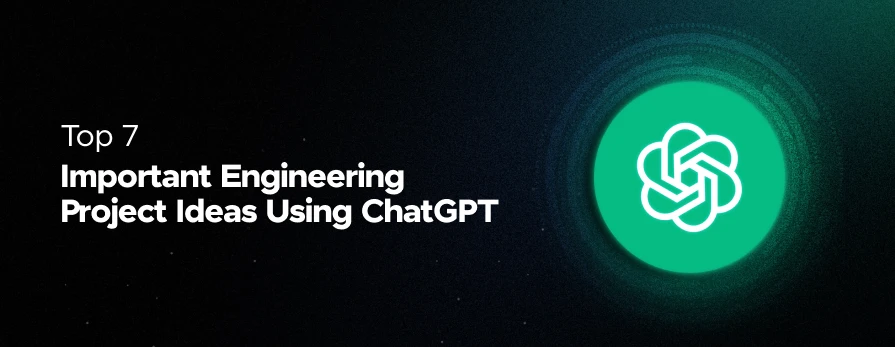

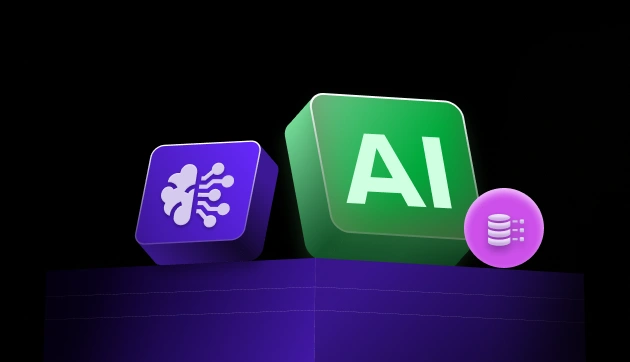

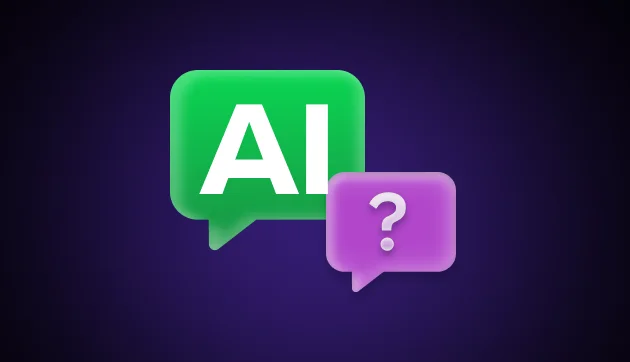
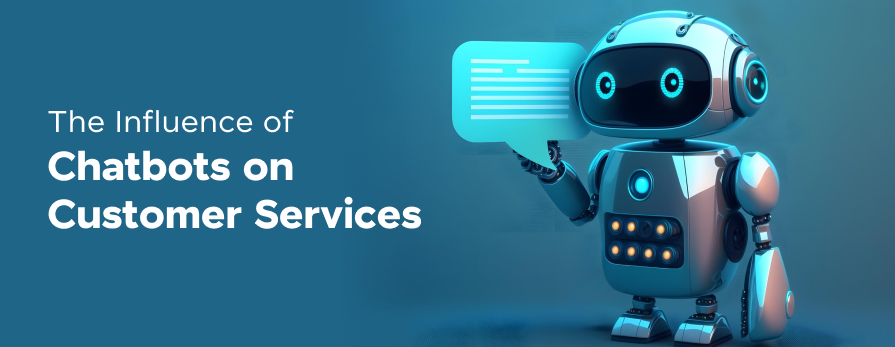

Did you enjoy this article?